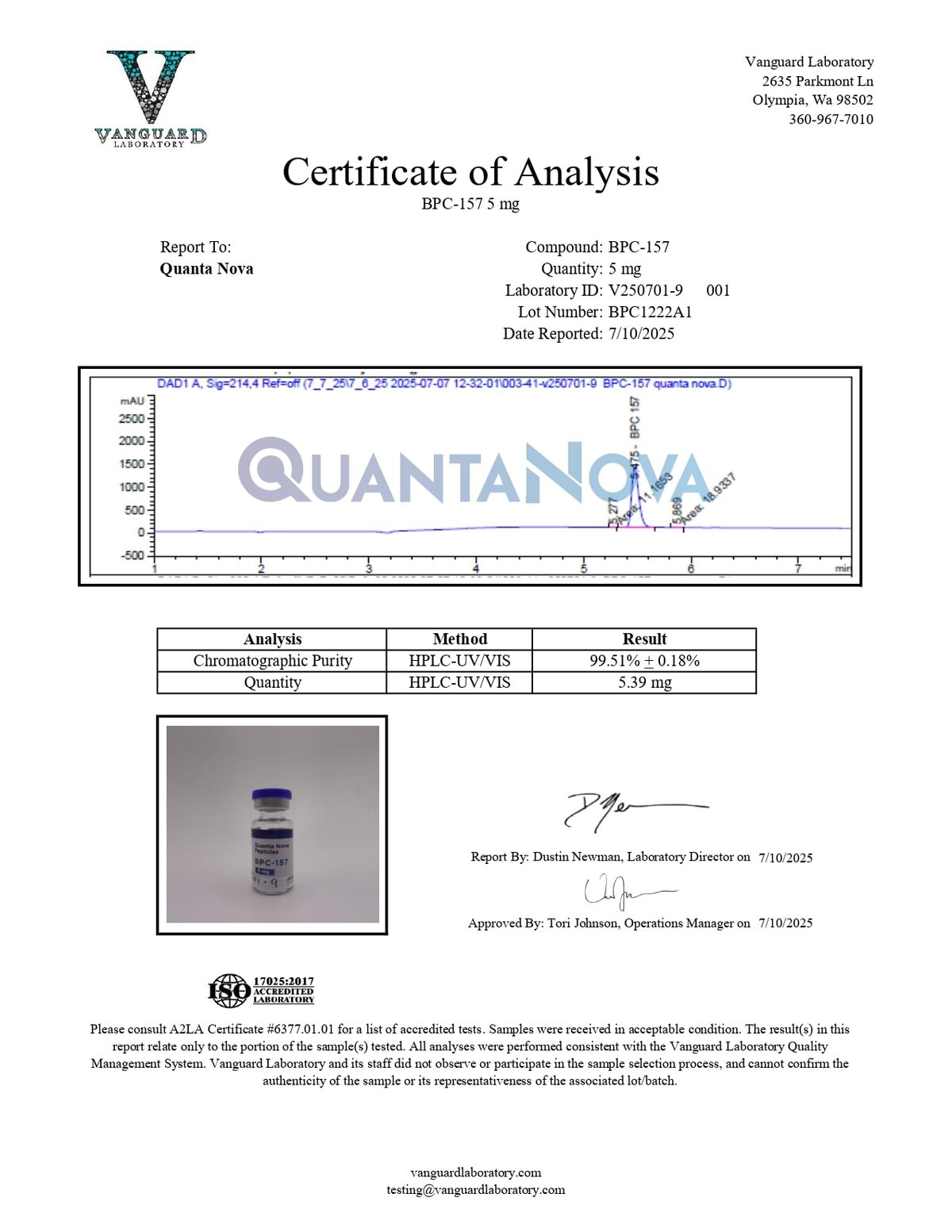Description
Product Overview
QuantaNova’s BPC-157 5mg comes in a 4-vial bundle of lyophilized powder. Each vial is freeze-dried in-house using our proprietary method. This technique helps preserve the peptide’s integrity during temperature shifts, including both heat and cold. As a result, the structure stays stable for up to 30 days before refrigeration or freezing is required.
We oversee the entire lyophilization process at our facility. This ensures consistent quality and control across every batch. To further guarantee product reliability, each lot is tested by Vanguard Laboratory, an ISO-certified third-party lab. Testing confirms Identity, Purity, Quantity, and Bacterial Endotoxins. Researchers choose QuantaNova for our focus on transparent testing, quality control, and dependable results.
BPC-157 Peptide Structure
-
Amino Acid Sequence: Gly-Glu-Pro-Pro-Pro-Gly-Lys-Pro-Ala-Asp-Asp-Ala-Gly-Leu-Val
-
Molecular Formula: C62H98N16O22
-
Molecular Weight: 1419.55 g/mol
-
CAS Number: 137525-51-0
Research Highlights of BPC-157
-
Studied for its potential role in supporting cellular repair and tissue regeneration
-
Explored for its influence on gastrointestinal system recovery
-
Investigated for neuroprotective properties in animal models
-
May support tendon and ligament recovery based on in vitro studies
-
Studied in relation to angiogenesis and vascular integrity
In-Depth Research Applications of BPC-157
Tissue Regeneration and Cellular Repair
BPC-157 is a synthetic pentadecapeptide derived from a natural gastric peptide. Research has shown significant interest in its potential role in tissue repair across multiple organ systems. In preclinical models, it has been observed to modulate cellular mechanisms that influence healing processes, particularly in muscle, skin, and connective tissue.
Gastrointestinal Research Models
BPC-157 has been frequently studied in gastrointestinal contexts, including in models simulating ulcerative or inflammatory conditions. Data suggest it may support mucosal integrity and promote epithelial regeneration under stress or chemically induced injury, making it a point of interest in GI-focused research.
Neuroprotective Mechanisms
There is increasing attention on BPC-157 for its interaction with neurological pathways. In rodent models, it has demonstrated potential neuroprotective activity following induced trauma, possibly by enhancing neuronal plasticity and balancing key neurotransmitters. These findings suggest further applications in studies focused on brain injury or memory retention.
Vascular Integrity and Angiogenesis
Studies have also explored BPC-157’s ability to influence angiogenesis and vascular stabilization. This includes support for endothelial cell function and microvascular flow, which may explain its impact on accelerated tissue recovery in models with vascular impairment.
Thanks to its solubility, compatibility with aqueous solutions, and resilience when lyophilized, BPC-157 remains one of the most versatile and stable peptides used in regenerative research settings.
Resources
- Tissue Regeneration and Cellular Repair
- Gastrointestinal Research Models
- Neuroprotective Mechanisms
- Vascular Integrity and Angiogenesis
Usage & Storage Guidelines of BPC-157
-
Handle using appropriate laboratory safety procedures.
-
Storage (Lyophilized): Store at -20°C.
-
After Reconstitution: Store between 2–8°C and use within 14–30 days.
-
Diluent Recommendation: Reconstitute with bacteriostatic water or a suitable research-grade diluent.
Legal Disclaimer
- This product is intended strictly for laboratory research purposes only. It is not a drug, food additive, cosmetic, or therapeutic substance, and must not be used in humans or animals. It is the buyer’s responsibility to handle the product safely and in accordance with applicable laws and regulations.








Reviews
There are no reviews yet